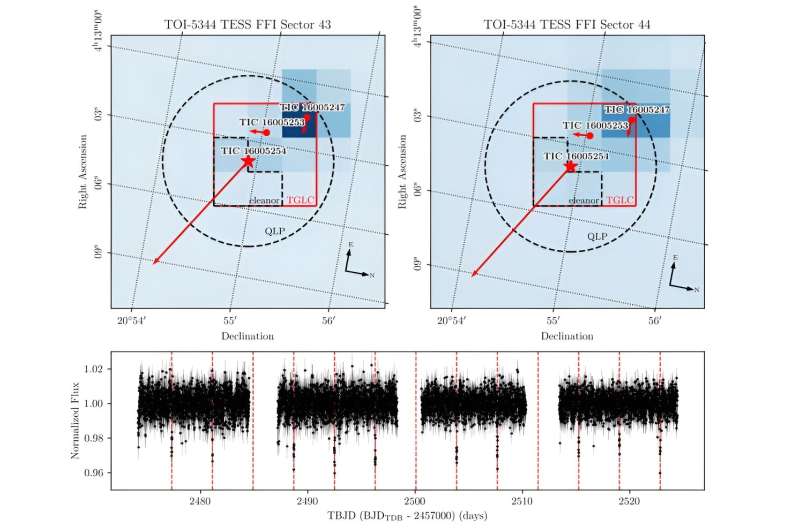November 6, 2023 report
This article has been reviewed according to Science X's editorial process and policies. Editors have highlighted the following attributes while ensuring the content's credibility:
fact-checked
preprint
trusted source
proofread
TESS discovers Saturn-like planet orbiting an M-dwarf star

Astronomers have discovered a new giant exoplanet orbiting an M-dwarf star using NASA's Transiting Exoplanet Survey Satellite (TESS). The newly detected alien world, designated TOI-5344 b is similar in size and mass to Saturn. The finding is reported in a paper published October 31 on the pre-print server arXiv.
To date, TESS has identified nearly 6,900 candidate exoplanets (TESS Objects of Interest, or TOI), of which 398 have been confirmed so far. Since its launch in April 2018, TESS, with its array of wide-field cameras, is conducting a survey of about 200,000 of the brightest stars near the sun with the aim of searching for transiting exoplanets—ranging from small and rocky, to giant alien worlds.
A team of astronomers led by Te Han of the University of California, Irvine, has now confirmed another TOI monitored by TESS. They identified a transit signal in the light curve of TOI-5344—an M dwarf located some 444 light years away from the Earth. The planetary nature of this signal was confirmed by follow-up ground-based observations.
"TOI-5344 b was discovered using TESS and confirmed with ground-based photometry, high contrast speckle imaging, and precise RVs [radial velocities]," the researchers wrote in the paper.
TOI-5344 b is nearly 10 times larger and 135 times more massive than the Earth, which yields a density at a level of 0.8 g/cm3. The planet orbits its host every 3.8 days, at a distance of some 0.04 AU. The equilibrium temperature of TOI-5344 b is estimated to be approximately 679 K.
Based on the derived parameters, the authors of the paper classified TOI-5344 b as a Saturn-like planet. They noted that it also has a comparable metal mass fraction to that of Saturn and that it joins a small but growing group of about 20 so-called GEMS—giant exoplanets around M-dwarf stars—with radii between 8 and 15 Earth radii, and at least 80 times more massive than our planet.
When it comes to the parent star TOI-5344, the study found that it has a radius of approximately 0.56 solar radii and its mass is 0.59 solar masses. The star is estimated to be 7.1 billion years old, has an effective temperature of 3,770 K, and its metallicity is estimated to be at a level of 0.48 dex—which makes it one of the most metal-rich transiting GEMS hosts.
Summing up the results, the researchers hope for further discoveries of exoplanets similar to TOI-5344, that could help us better understand the formation and evolution of GEMS in general.
"While GEMS are rare, the extensive grasp of TESS has yielded several new discoveries. With a gradually expanding sample size, the nature of GEMS formation will hopefully be unveiled," the scientists concluded.
More information: Te Han et al, TOI-5344 b: A Saturn-like planet orbiting a super-Solar metallicity M0 dwarf, arXiv (2023). DOI: 10.48550/arxiv.2310.20634
Journal information: arXiv
© 2023 Science X Network




















